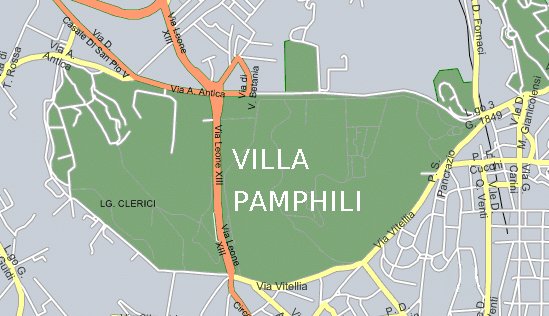|
.:: Ubi's Rome ::.
made in UbiLand |
|
|
Villa Pamphilj Villa Doria Pamphili (or "Pamphilj") covers an area of almost 2 square kilometer; it is considered one of the most important villas in Rome because still keeps, after a long time, both the disposition of the seventeenth century and the main characteristics of the eighteenth and nineteenth centuries. The complex is actually made of three parts: "pars urbana", which includes the palace and the sorrounding gardens; "pars fructuaria", made of a pine wood; "pars rustica", considered an agricultural area by all means. Inside, a river flows into a small lake with an elliptic island.  the map of Villa Pamphili The gardens are among the main features; they were quite an innovation in their arrangement in comparison the canons of the time: they develop around two othogonal axis, the first one perpendicular to the aqueduct, the second one that runs parallel to it. Applying this technique, an intersection in the garden is obtained by the lowest level and not around the palace. In the eighteenth century new elements were added to the "pars fructuaria" and, by the half of the same century and the beginning of the next one, Francesco Bettini created an "Orto Agronomico" (a sort of botanic garden for fruits and products of agriculture) in the Villa Vecchia (Old Villa). Around 1840, Prince Filippo Andrea V Doria Pamphilj, transformed the villa into a modern farm. To accomplish this, he annexed villas and vine fields already existing by Via Aurelia Antica (the Old Aurelia road, one of the roads from the Roman Empire) and in 1856 he also bought Villa Corsini. The end of the short-lived Repubblic of the Rome produced problems of all sorts and dameges in the City, and after that some changes were made for the construction of plants for agricultural purposes. By the end of the nineteenth century, curving tracks were built, to underline the characteristics and beauty of the view and to unify the various parts of Villa Pamphilj. Between 1896 and 1902 the Family Chapel was erected; a building that was interesting from the artistic point of view because of its neo-medieval features. In 1939 the City of Rome started the occupation and alienation of Villa Doria Pamphilj, that was complete by the year 1971. Nowadays, Villa Pamhili sees the citizens of Rome coming numerous to enjoy its wide areas, where it is very pleasant to walk and to bike; inside its valleys it does not even seem to be in a city. A bridge for pedestrians weas built in 2003 to allow trepassing from one side to the opposite one, as the two parts are divided by a large road, via Leone XIII, which is dangerous to cross. |
|
